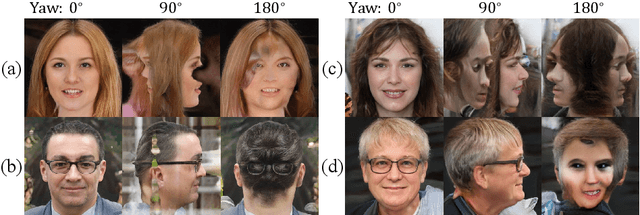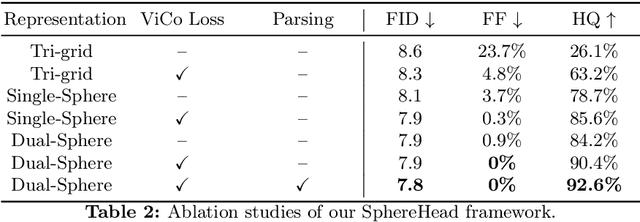Heyuan Li
Exploring Disentangled and Controllable Human Image Synthesis: From End-to-End to Stage-by-Stage
Mar 25, 2025Abstract:Achieving fine-grained controllability in human image synthesis is a long-standing challenge in computer vision. Existing methods primarily focus on either facial synthesis or near-frontal body generation, with limited ability to simultaneously control key factors such as viewpoint, pose, clothing, and identity in a disentangled manner. In this paper, we introduce a new disentangled and controllable human synthesis task, which explicitly separates and manipulates these four factors within a unified framework. We first develop an end-to-end generative model trained on MVHumanNet for factor disentanglement. However, the domain gap between MVHumanNet and in-the-wild data produce unsatisfacotry results, motivating the exploration of virtual try-on (VTON) dataset as a potential solution. Through experiments, we observe that simply incorporating the VTON dataset as additional data to train the end-to-end model degrades performance, primarily due to the inconsistency in data forms between the two datasets, which disrupts the disentanglement process. To better leverage both datasets, we propose a stage-by-stage framework that decomposes human image generation into three sequential steps: clothed A-pose generation, back-view synthesis, and pose and view control. This structured pipeline enables better dataset utilization at different stages, significantly improving controllability and generalization, especially for in-the-wild scenarios. Extensive experiments demonstrate that our stage-by-stage approach outperforms end-to-end models in both visual fidelity and disentanglement quality, offering a scalable solution for real-world tasks. Additional demos are available on the project page: https://taited.github.io/discohuman-project/.
DiffPortrait360: Consistent Portrait Diffusion for 360 View Synthesis
Mar 19, 2025



Abstract:Generating high-quality 360-degree views of human heads from single-view images is essential for enabling accessible immersive telepresence applications and scalable personalized content creation. While cutting-edge methods for full head generation are limited to modeling realistic human heads, the latest diffusion-based approaches for style-omniscient head synthesis can produce only frontal views and struggle with view consistency, preventing their conversion into true 3D models for rendering from arbitrary angles. We introduce a novel approach that generates fully consistent 360-degree head views, accommodating human, stylized, and anthropomorphic forms, including accessories like glasses and hats. Our method builds on the DiffPortrait3D framework, incorporating a custom ControlNet for back-of-head detail generation and a dual appearance module to ensure global front-back consistency. By training on continuous view sequences and integrating a back reference image, our approach achieves robust, locally continuous view synthesis. Our model can be used to produce high-quality neural radiance fields (NeRFs) for real-time, free-viewpoint rendering, outperforming state-of-the-art methods in object synthesis and 360-degree head generation for very challenging input portraits.
SphereHead: Stable 3D Full-head Synthesis with Spherical Tri-plane Representation
Apr 08, 2024



Abstract:While recent advances in 3D-aware Generative Adversarial Networks (GANs) have aided the development of near-frontal view human face synthesis, the challenge of comprehensively synthesizing a full 3D head viewable from all angles still persists. Although PanoHead proves the possibilities of using a large-scale dataset with images of both frontal and back views for full-head synthesis, it often causes artifacts for back views. Based on our in-depth analysis, we found the reasons are mainly twofold. First, from network architecture perspective, we found each plane in the utilized tri-plane/tri-grid representation space tends to confuse the features from both sides, causing "mirroring" artifacts (e.g., the glasses appear in the back). Second, from data supervision aspect, we found that existing discriminator training in 3D GANs mainly focuses on the quality of the rendered image itself, and does not care much about its plausibility with the perspective from which it was rendered. This makes it possible to generate "face" in non-frontal views, due to its easiness to fool the discriminator. In response, we propose SphereHead, a novel tri-plane representation in the spherical coordinate system that fits the human head's geometric characteristics and efficiently mitigates many of the generated artifacts. We further introduce a view-image consistency loss for the discriminator to emphasize the correspondence of the camera parameters and the images. The combination of these efforts results in visually superior outcomes with significantly fewer artifacts. Our code and dataset are publicly available at https://lhyfst.github.io/spherehead.
DSFNet: Dual Space Fusion Network for Occlusion-Robust 3D Dense Face Alignment
May 19, 2023Abstract:Sensitivity to severe occlusion and large view angles limits the usage scenarios of the existing monocular 3D dense face alignment methods. The state-of-the-art 3DMM-based method, directly regresses the model's coefficients, underutilizing the low-level 2D spatial and semantic information, which can actually offer cues for face shape and orientation. In this work, we demonstrate how modeling 3D facial geometry in image and model space jointly can solve the occlusion and view angle problems. Instead of predicting the whole face directly, we regress image space features in the visible facial region by dense prediction first. Subsequently, we predict our model's coefficients based on the regressed feature of the visible regions, leveraging the prior knowledge of whole face geometry from the morphable models to complete the invisible regions. We further propose a fusion network that combines the advantages of both the image and model space predictions to achieve high robustness and accuracy in unconstrained scenarios. Thanks to the proposed fusion module, our method is robust not only to occlusion and large pitch and roll view angles, which is the benefit of our image space approach, but also to noise and large yaw angles, which is the benefit of our model space method. Comprehensive evaluations demonstrate the superior performance of our method compared with the state-of-the-art methods. On the 3D dense face alignment task, we achieve 3.80% NME on the AFLW2000-3D dataset, which outperforms the state-of-the-art method by 5.5%. Code is available at https://github.com/lhyfst/DSFNet.
 Add to Chrome
Add to Chrome Add to Firefox
Add to Firefox Add to Edge
Add to Edge